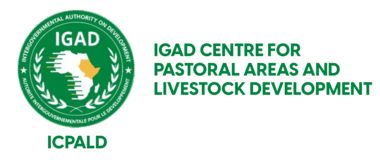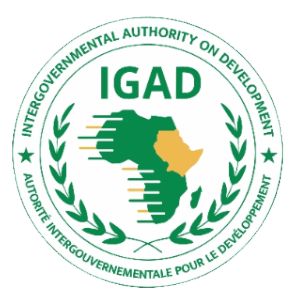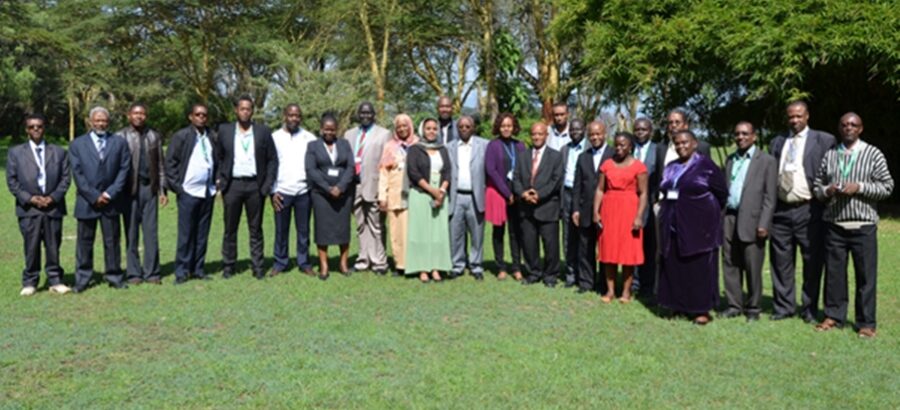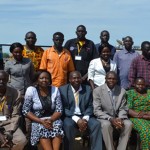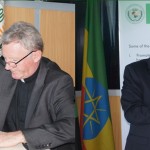- Introduction
The 3rd Regional Integration Support Programme (RISP3) is a follow-up phase to RISP1 (2005-2010) and RISP2 (2010 – 2013). The RISP3 programme seeks to support well selected, high priority and complementary activities to accelerate domestication and implementation of regional commitments including targeted national consultations and consensus building, background analytical work, reviews to identify gaps between current national laws and regional commitments, drafting of new legislation to comply with regional decisions, and strengthening national and regional institutions involved in coordination and implementation of regional integration activities.The main instruments of the IGAD support to member states will be capacity development, information gathering and analysis, advocacy and promotion of issues, and promotion of appropriate policy and intervention development in member states.
The workshop is based on a consultancy work for developing IEC materials, which will be reviewed and enriched, and also on an idea to review knowledge exchange, mutual learning and dissemination in the region.
- Objectives
The objectives of the workshop were:
- To present and discuss some prepared IEC materials in order to identify common aspects and possibilities for mutual learning. As well the draft reports will be reviewed and enriched.
- Share useful experiences, good practices and lessons from/with IGAD MS.
- Identify themes and modalities for further study and knowledge exchange
- To review and discuss how knowledge related issues are shaped in the region and within IGAD MS and recommend a way forward
- Proceedings
The Workshop was held at the Lake Naivasha Country Club Hotel in Naivasha, Kenya on 10th – 11th November 2015. The meeting was attended by 30 participants drawn from IGAD member states, and IGAD Centre for Pastoral Areas and Livestock Development (ICPALD).
Dr. Solomon Munyua Director of ICPALD Gave the Welcome address with particular emphasis on the overall objectives of the workshop and the expected outcomes he also sincerely thanked all participants for making time to come and attend this Regional workshop. Then the workshop was officially opened by Mr Okoth Nasser on behalf of Ministry of Foreign Affairs, Kenya. He sincerely thanked all participants for making time to come and attend this Regional workshop and also highlighted the importance of knowledge exchange, mutual learning and dissemination of information in the IGAD region. Then Dr Osman Babikir briefly outlined the workshop objectives.
3.1 Day one:
After the opening session, the second session was started by a background presentation highlighting the meanings of knowledge, data and information with some emphasis on pastoral and agro-pastoral livelihoods. Then two main presentations were given covering issues of the IEC materials including situational analysis and some samples of the prepared knowledge materials. The first presentation was trying to give a broad idea about the available information, the gaps in IEC materials and some recommendations covering the main identified themes on livestock, dryland farming and alternative livelihoods sub-sectors.
During the plenary discussion a number of questions and comments forwarded to the presenters among the issues raised these were found to be the most outstanding issues:
- The conceptual meaning of the terminologies of Knowledge, data and information was well clarified .
- Participants commented on all gaps identified by the consultant with a general statements there are no IET Materials instead of using the word there are limited efforts to develop IET Materials
- The role of NGOs BCC and rural electrification not well addressed or overlooked
- The Vital role of Media with the wide area of coverage to address the pastoral communities in there Owen media of communication totally ignored
- With regard to LITS the success story of Namibia and Botswana could be a model or a very good example for the IGAD region to learn from despite considering cultural and contextual differences.
- IEC approach is one of the possible approaches that could be used to disseminate knowledge. Other tools could also be used.
- When packaging and disseminating knowledge we have to consider socio-cultural acceptance and economic feasibility.
- There are good examples of best practices and tools used by some NGOs which can be documented and shared widely in the region.
- Participants also learned in general about how to methodologically prepare IEC materials
- We have to include all actors along the value chain (especially the communities) when preparing any knowledge materials for any sub-sector.
The first day was concluded by distribution of participants into three groups based on the three sub-sectors. The assignment was to discuss different issues with emphasis on packaging of innovative knowledge activities, media role in dissemination and how to create linkages and networks between different actors along the chain.
3.2 Day Two:
The first session was started by giving the participants time to finalize their group discussion and prepare their presentations. Then the second session was devoted to some presentations including recap of the first day, presentation of ICPALD communication strategy draft report and then this was followed by group presentations.
During this session the participants first discussed some issues in relation to the first two presentations. The consultant was advised to take some comments such as considering the title, the stakeholder analysis, and how can ICPALD use it as a marketing strategy for better positioning.
3.3 Group presentations and discussion:
3.3.1 Group One: Livestock Sub-sector:
This group prioritized their themes in production (feed, breeds and genetics), health (transboundary diseases and zonosis) and marketing aspects (value addition and market access). Gaps for the production theme were identified in characterization and documentation of indiginous breeds, support by legal frameworks and policy. Feed gaps were inadequate knowledge products for rangeland management, fodder production and lack of strategic feed reserves. Regarding health theme the group thought it was well covered. For market access theme, gaps were in pastoral associations, cooperatives, lack of cedit and insurance facilities.
The group also looked into how to be innovative in packaging knowledge for the use of pastoralists given that the media agents can use the available communication tools and come down from the urban centres to give time and resources for effective engagement with those marginalized communities. Institutions working on research and extension are so many both at regional and national contexts. The only missing thing is the effective engagement between those institutions and at the same time there is a wide gap between them, media channels and the pastoral communities. Of course this will be exuberated by the missing link between those communities and the policy makers, as well as between the research and extension institutions and policy makers. However during the discussion some participants mentioned that coordination and collaboration between all players will be vital for sustainable and effective knowledge sharing.
In terms of good and bad practices the group mentioned some examples despite the fact that these may need documentation and sharing as a learning lessons for others.
Finally as a way forward, the group recommended that there should be an effective communication strategy with critically defined role for all actors, to draw the attention of the governments towards the forgotten pastoral communities and create awareness for better attitudinal change.
3.3.2 Group Two: Dryland Farming Sub-sector:
The number of identified themes in this sub-sector indicate that dryland farming is not well captured by development actors in the region. These themes were centered around drought resistance crops, research, extension, appropriate farming techniques, market infrastructures among others. Gaps were also too many, but mainly targeting access to finance, inputs, markets, research and policies. The group perceived the prioritized needs in issues related to change attitude in technology acceptance, favourable policies, capacity building and media coverage. To fill the gaps, the group was suggesting to have very effective media tools that create and work in tandem with research and extension actors to disseminate appropriate knowledge to enhance building resilience of the communities of the dryland areas. However, the group reported that there is a wide range of institutions dealing with research, extension and communication institutions which can if well connected, do good efforts in linking producers along the chain.
Regarding good/bad practices, countries mentioned some good, though not documented and shared, practices. For example the group mentioned that in Uganda, the government allocated some money to promote agribusiness, in Ethiopia they support introduction of new appropriate crop varieties and they also provide finance to producers and in Sudan linkages to micro-finance institutions was also mentioned as good lesson.
As a way forward, the group was suggesting that governments to increase their public resources to this sub-sector, as well, coordination across ministries need to be enhanced. Promotion of tolerance to drought, use of ICT, strengthening of extension and financial supporting to networking were also mentioned as recommendations.
3.3.3 Group Three: Alternative Livelihoods Sub-sector:
The group was identifying the themes as non-wood forest products, artisanal mining, small scale enterprises, crafting and casual labour. Gaps were so many among which they include inadequacy in: supportive policies, business and marketing skills, awareness, financial and credit, and infrastructure, equipments and tools. For each theme of this sub-sector, the group also identified as gaps, lack of value addition, lack of appropriate communication linkages, lack of standards and the deteriorated working environments among others.
In terms of prioritization, the group mentioned that first it will be of help to have a mapping process of sustainable livelihood and potential areas of production. Then they also mentioned other priorities such as availing of supportive policies and frameworks, incubation centers and knowing of the contribution of these products to the national and household economies. To fill these gaps in knowledge access, they have suggested various tools such as knowledge fairs, exhibitions, mobile cinemas, community learning centers, and exposure visits. Networking is also possible through knowledge forums, learning institutions and social groups.
The media agents and channels are of course an important means in knowledge sharing. They need to consider cautiously the framing of the message and how it could be very effective in bringing a change. They also need to have a clear communication strategy and also the group discussed the importance of promoting the culture of preparing communication strategies for ministries, communication agents and other public and private institutions. For media role also giving time and resources to the rural communities is very fundamental as mostly they give more time and resources to the urban communities and politics. It is also important to create linkages and coordination with other relevant technical government institutions, and research units to get timely and based on evidence information to craft their messages.
Among the good practices the group mentioned some examples such as farmer to farmer extension and among bad practices they thought about the negative effects of charcoal trading and the lack of diversification within the pastoral communities.
As a way forward, the group suggested to strengthen/support development of relevant legal and policy frameworks, piloting of incubation centers and promoting of knowledge sharing through effective and sustained communication channels.
- MAIN OUTPUTS/RECOMMENDATIONS
- For livestock sub-sector, in addition to the way forward came from the group work, the participants recommended to look into issues of land use mapping and resource-based conflicts. Also in addition to value addition, they also recommended to look into feed reserve strategies and compliance to market access.
- For dryland farming group, in addition to what came from group work, the participants recommended to look into documentation of good practices of using tolerant to drought seed varieties, use of cereals after adding value to them as animal feeds and use of relevant irrigation techniques.
- For alternative livelihoods sub-sector, the participants, in addition to the group way forward, suggested to enhance attitudinal change towards market orientation through capacity building, and also promotion of public private partnerships was mentioned.
- In general, the following were also foreseen as cross cutting points for the three sub-sectors:
- There is need to look into the three sub-sectors integratively to enhance food security and building of resilient pastoral livelihoods.
- This may also need some advocacy to promote coexistence of all the sub-sectors together for healthy environments.
- There is apparent gap in technical knowhow on how to keep strategic reserves of animal feeds.
- There is need to promote the culture of early warning systems to share widely information related to weather predictions, pests and diseases among others.
- There is need to explore, document and share widely the existing indigenous knowledge and traditional practices
- There is need to create an effective regional knowledge exchange platform/network for ASALs.
